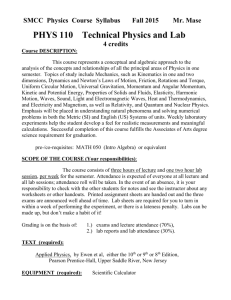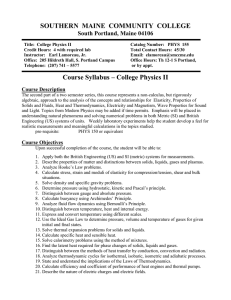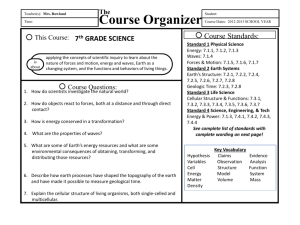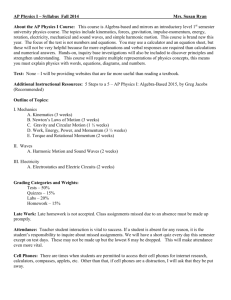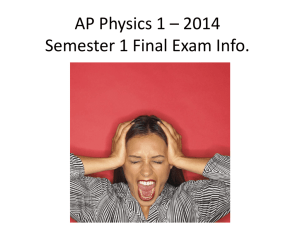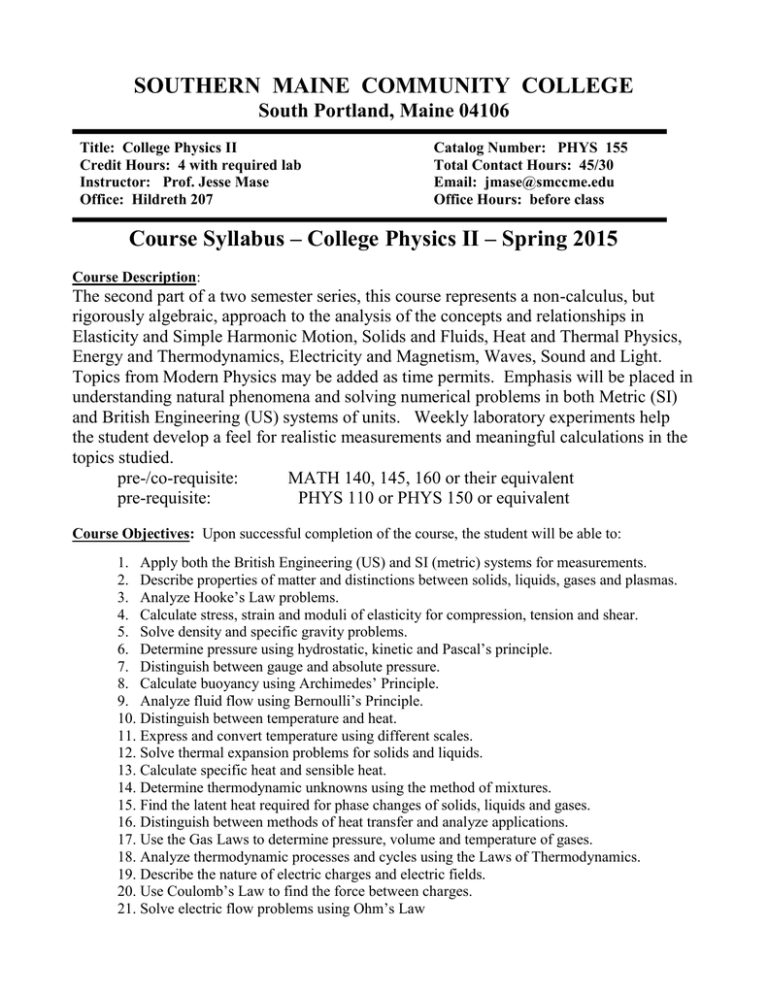
SOUTHERN MAINE COMMUNITY COLLEGE
South Portland, Maine 04106
Title: College Physics II
Credit Hours: 4 with required lab
Instructor: Prof. Jesse Mase
Office: Hildreth 207
Catalog Number: PHYS 155
Total Contact Hours: 45/30
Email: jmase@smccme.edu
Office Hours: before class
Course Syllabus – College Physics II – Spring 2015
Course Description:
The second part of a two semester series, this course represents a non-calculus, but
rigorously algebraic, approach to the analysis of the concepts and relationships in
Elasticity and Simple Harmonic Motion, Solids and Fluids, Heat and Thermal Physics,
Energy and Thermodynamics, Electricity and Magnetism, Waves, Sound and Light.
Topics from Modern Physics may be added as time permits. Emphasis will be placed in
understanding natural phenomena and solving numerical problems in both Metric (SI)
and British Engineering (US) systems of units. Weekly laboratory experiments help
the student develop a feel for realistic measurements and meaningful calculations in the
topics studied.
pre-/co-requisite:
MATH 140, 145, 160 or their equivalent
pre-requisite:
PHYS 110 or PHYS 150 or equivalent
Course Objectives: Upon successful completion of the course, the student will be able to:
1. Apply both the British Engineering (US) and SI (metric) systems for measurements.
2. Describe properties of matter and distinctions between solids, liquids, gases and plasmas.
3. Analyze Hooke’s Law problems.
4. Calculate stress, strain and moduli of elasticity for compression, tension and shear.
5. Solve density and specific gravity problems.
6. Determine pressure using hydrostatic, kinetic and Pascal’s principle.
7. Distinguish between gauge and absolute pressure.
8. Calculate buoyancy using Archimedes’ Principle.
9. Analyze fluid flow using Bernoulli’s Principle.
10. Distinguish between temperature and heat.
11. Express and convert temperature using different scales.
12. Solve thermal expansion problems for solids and liquids.
13. Calculate specific heat and sensible heat.
14. Determine thermodynamic unknowns using the method of mixtures.
15. Find the latent heat required for phase changes of solids, liquids and gases.
16. Distinguish between methods of heat transfer and analyze applications.
17. Use the Gas Laws to determine pressure, volume and temperature of gases.
18. Analyze thermodynamic processes and cycles using the Laws of Thermodynamics.
19. Describe the nature of electric charges and electric fields.
20. Use Coulomb’s Law to find the force between charges.
21. Solve electric flow problems using Ohm’s Law
22. Find current, voltage, resistance and power in simple circuits.
23. Explain magnetism and electrical current using Ampere’s, Faraday’s and Lenz’s Laws.
24. Distinguish between generators and motors.
25. Describe the nature and characteristics of alternating current.
26. Describe the characteristics of mechanical and electromagnetic waves.
27. Analyze sound waves, calculate decibels and explain the Doppler effect.
28. Contrast the wave and particle nature of light
29. Solve problems involving the speed of light.
30. Apply principles of photometry to technical problems.
31. Apply the laws of reflection and refraction
Learning Outcome Competences:
Critical Thinking: Upon completion of this course a student will be able to evaluate
information to make educated decisions based on the fusion of experience, reason and
training.
1. A student can interpret information logically by selecting and organizing relevant facts and
opinions and identifying the relationships among them.
2. A student can analyze an issue or problem by separating it into it component parts and
investigating the relationship of the parts to the whole.
3. A student can synthesize information by combining ideas from multiple sources to come to an
independent conclusion.
4. A student can evaluate information by making informed judgments as to whether the
information is accurate, reliable or useful.
5. A student can apply theory to practice.
Quantitative Methods: Upon completion of this course a student will be able to logically
analyze and solve quantitative problems.
1. Recognize problems that can be solved by quantitative methods.
2. Identify the quantitative components of a problem.
3. Select an appropriate mathematical method to solve a problem
4. Demonstrate accurate computational and/or algebraic skills to solve a problem.
5. Estimate reasonableness of answers to problems.
6. Record data accurately using appropriate methods, tools, and technology.
7. Interpret information presented in charts and graphs
8. Use measurement concepts and correct labels to solve problems
9. Convert between English and Metric units.
Science and Technology: Upon completion of this course a student will be able to apply
the Scientific Method and employ the technological skills necessary to function effectively in
an increasingly complex world.
Topical Outline of Instruction
Week 1
Week 2
Week 3
Week 4
Week 5
Week 6
Week 7
Week 8
Solids and Fluids; Elasticity, Pressure
Lab: Hooke’s Law of Elasticity
Archimedes’ Principle; Fluid Dynamics
Lab: Archimedes’ Principle of Buoyancy
Temperature Scales; Thermal Expansion; The Gas Laws
Lab: Coefficient of Linear Expansion
The Kinetic Theory of Gases
Exam #1 in Lab Period
Heat, Specific Heat and Calorimetry
Lab: Specific Heat Capacity
Phase Changes, Latent Heat; Heat Transfer
Lab: Heats of Fusion and Vaporization
Laws of Thermodynamics; Heat Engines; Refrigeration
Lab: Absolute Zero
Exam # 2 in Lab Period
Chapter 9.1 - 9.2
Chapter 9.3 – 9.4
Chapter 10.1 – 10.3
Chapter 10.4 – 10.5
Chapter 11.1 – 11.2
Chapter 11.3 – 11.4
Chapter 12.1 – 12.6
Spring Break – March 9-14 – No Classes
Week 9
Week 10
Week 11
Week 12
Week 13
Week 14
Week 15
Week 16
Coulomb’s Law and Electric Fields
Lab: Joule’s Law (electrical version)
Series, Parallel and Compound Circuits; Voltage,
Current and Resistance; Power
Lab: Ohm’s Law, Series and Parallel Circuits
Magnetism and Ampere’s Law; Generators and Motors;
Faraday’s and Lenz’s Laws; AC and Transformers
Lab: Electric Motors or Transformers
SHM Vibrations and Waves; Standing Waves; Resonance
Exam # 3 in Lab Period
Sound; Intensity and Decibels; Doppler Effect
Lab: Transverse Standing Waves
Light and Electromagnetic Waves
Lab: Speed of Sound in Air
Photons and Quantum Physics; Wave-Particle Duality
Lab: Inverse Square Law of Light Intensity
Exam # 4 in Lab Period
Chapter 15.1 – 15.5
Chapters 16.1, 17.1, 17.3,
17.4, 18.1 – 18.5
Chapter 19.1 – 19.7
Chapter 20.1 – 20.4
Chapter 13.1 – 13.5
Chapter 14.1 – 14.6
Chapter 22.1 – 22.5
Chapter 27.1 – 27.5
Useful things to note:
1.) Attendance is taken in lectures and labs; you get a “1” if you are
present, and a “0” if you are not. For an attendance grade, if you are
present for thirty seven out of forty five classes, your attendance grade
is 37/45 which is 0.82 or 82%.
2.) Take good notes in lecture and labs by writing down what I write on the
board. This is your single best way to get and organize the information
you need to succeed in this course. My lecture examples are carefully chosen.
3.) Lab sheets which become your lab report are handed out in lab periods.
They can be filled out completely in the lab period, or you have up to
a week to finish and turn them in. After that points are deducted for lateness.
4.) Bring your own calculator to all labs and exams. Learn to use it for
exponents, scientific notation, logarithms and trig functions (I can help
you). You are not going to do well if you try to take an exam without a
calculator! Your phone calculator may be sufficient, if it has the above
functions on it.
5.) Worksheets on each unit are provided with solutions. It is in your best
interests to work these problems because the worksheets are made of
old exam questions!
6.) You may bring a sheet of notes to an exam. A standard 8.5 x 11 sheet
of paper with notes in your own handwriting on both sides will prevent
you having to memorize anything for exams. Do not let that lull you
into a false sense of security. You still have to study, review your class
notes, make your sheet of notes, master using your calculator and
practice problems and questions to prepare.
7.) The best way to learn physics is to do problems and answer questions.
There are many, many questions and problems with each chapter in the
textbook, but they only help you learn if you spend time doing them.
We hand out sheets of suggested multiple-choice questions, conceptual
questions and problems for you to practice with.
Course Requirements
This course meets for three 1 hour or two 1.5 hour lecture/demonstration/problems solving
sessions and one 2 hour laboratory session each week. Attendance is expected and required at
all sessions unless a valid reason, satisfactory to the instructor, is provided. Individual
instructors will state their particular specification beyond school policy which may mean
providing supporting documentation for the absence. It is always the students’ responsibility to
make up and complete missed coursework on their own time and due upon their return.
Excessive absences will result at the instructor’s discretion in an administrative failure.
Both class and lab work will require a reasonable facility in the use of basic algebra and right
triangle trigonometry. Students not proficient in mathematics should plan to seek out additional
assistance beyond class time through the Academic Achievement Center, Math Dept., Physical
Science Dept. help sessions, instructor’s office hours or a private tutor.
Student Evaluation and Grading
Homework in the form of reading, questions, and problems is assigned daily and reasonable
effort is expected prior to the next class. A notebook check or pop quiz can happen at any time.
Laboratory reports are due at the beginning of the next lab period following the previous
week’s experiments. Late reports will have points deducted. There will be 2 major exams over
the course of the semester. All exams are announced well in advance and consist of multiple
choice concept questions and mathematical problem solving.
The final course grade will be computed as follows:
Exams and Attendance
75%
Laboratory
25%
Text, Tools, and/or Supplies:
COLLEGE PHYSICS (required) by Wilson, Buffa, and Lou, 7th (or earlier) edition,
Pearson / Prentice-Hall, 2010 with Student Study Guide
Notebook (required, preferably loose leaf or spiral and dedicated to physics)
Scientific calculator (required)
End-of-Course Evaluation
In order to gain access to final course grades, students must complete evaluations for each course attended at SMCC.
Evaluations are submitted online and can be accessed through the student portal site. Students can access the course
evaluation report beginning two weeks before the end of classes. The deadline for submission of evaluations occurs 24
hours after the last day of classes each semester. Instructors will announce when the online course evaluation is available.
ADA Syllabus Statement
Southern Maine Community College is an equal opportunity/affirmative action institution and employer. For more
information, please call 207-741-5798.
If you have a disabling condition and wish to request accommodations in order to have reasonable access to the programs
and services offered by SMCC, you must register with the disability services coordinator, Mark Krogman, who can be
reached at 741-5629. There will be some documentation for your teachers that must be supplied before accommodations
can be given. Further information about services for students with disabilities and the accommodation process is available
upon request at this number.
SMCC Pay-for-Print Policy
Students can print 150 pages per semester free of charge. If you print over 150 pages, you will be charged 10 cents per page
to your student billing account for tuition and fees. Leftover pages from each semester will not be rolled over to the
following semester. The College’s pay-for-print system monitors printing on all public printers (i.e. those in general access
labs, library printers, the Academic Achievement Center, Noisy Lounge and technology labs). Each time you log-in to the
system, the print station displays the remaining print quota. Once the printing quota has been exceeded, users will be
charged $ 0.10 per page or $.05 per side if the printer prints on both sides on their student accounts on a monthly basis.
Color printouts will be charged at 11 page units. This means each color printout will count as 11 pages toward the quota
and will cost $1.10.
Add-Drop Policy
Students who drop a course during the one-week “add/drop” period in the fall and spring semesters and the first three days
of summer sessions receive a 100% refund of the tuition and associated fees for that course. Please note any course that
meets for less than the traditional semester length, i.e., 15 weeks, has a pro-rated add/drop period. There is no refund for
non-attendance.
Withdrawal Policy
A student may withdraw from a course only during the semester in which s/he is registered for that course. The withdrawal
period is the second through twelfth week of the fall and spring semesters and the second through ninth week of twelveweek summer courses. This period is pro-rated for shorter-length courses. To withdraw from a course, a student must
complete and submit the appropriate course withdrawal form, available at the Enrollment Service Center (no phone calls,
please). The designation “W” will appear on the transcript after a student has officially withdrawn. A course withdrawal is
an uncompleted course and may adversely affect financial aid eligibility. Failure to attend or ceasing to attend class does
not constitute withdrawal from the course. There is no refund associated with a withdrawal.
Plagiarism Statement
Adherence to ethical academic standards is obligatory. Cheating is a serious offense, whether it consists of taking credit for
work done by another person or doing work for which another person will receive credit. Taking and using the ideas or
writings of another person without clearly and fully crediting the source is plagiarism and violates the academic code as
well as the Student Code of Conduct. If it is suspected that a student in any course in which s/he is enrolled has knowingly
committed such a violation, the faculty member should refer the matter to the College’s Disciplinary Officer and
appropriate action will be taken under the Student Code of Conduct. Sanctions may include suspension from the course and
a failing grade in the course. Students have the right to appeal these actions to the Disciplinary Committee under the terms
outlined in the Student Code of Conduct.

